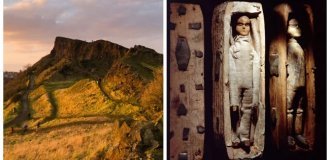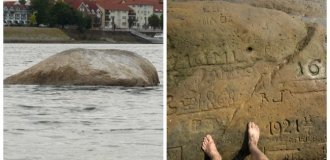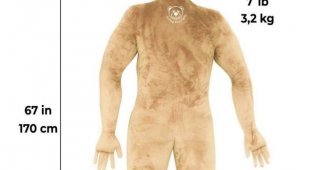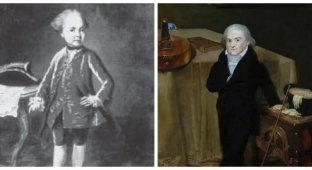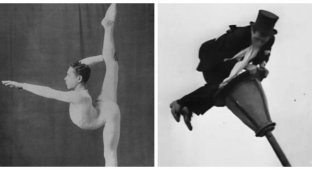Passed away, taking his daughter with him: tightrope walker Joseph Eisemann (5 photos)
In the circus world, aerial acrobats, tightrope walkers, and everyone who works under the big top and constantly risks their lives are considered the elite. The so-called "carpet" ones do not have the risk of falling onto a hard surface from a great height with the possibility of remaining crippled forever. Some of these risky people begin to work outdoors, where it is often even more dangerous. 
Josef Eisemann was born in what is now Serbia in 1911. His grandfather (on his mother’s side) was from a famous circus dynasty and from an early age taught his beloved grandson to walk on a tightrope. The “old” tightrope walkers never used the safety net, considering it weakness and uncertainty. Joseph adopted the experience of previous generations. In Yugoslavia, Eisemann was a successful artist and his troupe toured throughout Europe.
Everything changed when Hitler attacked Yugoslavia on April 6, 1941. Already on April 17, the country declared capitulation.
Josef then served in the army of Yugoslavia, but refused to fight against his own people and, along with thousands of refugees, rushed to Romania. Afterwards, with his family, he moved to Vienna, having lost all his property in his homeland. The war years were difficult - entertainment did not bring money and Joseph became a tailor. It’s amazing how he managed to avoid mobilization, but only in 1945 was he forcibly sent to the militia, where in the first battle he was captured by the French. He managed to return to his wife and two children only after two years spent in a filtration camp. 
Eisemann
Josef began working as a cutter in a tailor shop, but was planning his return to the ropes. Training, sports: he pulled a rope between the houses, put on special slippers made of soft leather and, taking a balancing pole, “walked” between the houses of Old Vienna. The townspeople were shocked. And still - no insurance, except for hooks at the ends of the pole. If you were lucky, they could have time to catch the cable in case of a fall.
Risk? Undoubtedly. But money finally began to appear in the family when random spectators began throwing coins to the tightrope walker. Joseph's eldest daughter and son collected the money.
But Eisemann dreamed of his pre-war glory, of touring Europe (and maybe all over the world). It was necessary to make a splash with your performance so that people would start talking about it not only in Vienna.
Joseph decided to cross the Danube Canal, a branch of the river flowing to the historical center of Vienna. Before the war, this was one of the best areas of the city, plus it had an excellent view, which would help attract hundreds, or even thousands of spectators.
The city hall allowed Eisemann to string a rope through the canal for exactly one month. The height above the water is a seven-story building. The length of the rope is 120 meters. But, due to the fact that most of the buildings were destroyed during the war, the slope of the cable was with a height difference of three meters. This made the trick even more dangerous. And Joseph only had a month to do everything, including training, which he spent only ten days on.
On July 5, 1949, the first public performance took place. To further warm up the crowd, the tightrope walker first walked himself, and then carried his own 12-year-old son on his shoulders. That's how much he had no doubt about his own skill. 
Eisemann
Over the next ten days, with short breaks due to weather conditions, Eisemann held two performances a day: in the morning and in the evening. Seats with the best view cost 1 to 1.5 shillings, and several thousand spectators attended each performance.
To bring the crowd into ecstasy, Joseph began to show acrobatic tricks on the rope, but this was not enough for his ambitions. He wanted to do something that was not done in any circus in the world.
And he offered to carry anyone who dared to do so on his own shoulders. A photographer from one of the Viennese newspapers agreed, realizing that photographs of Vienna taken from Eisemann's shoulders would glorify him. Everything was already prepared, but the police intervened at the last moment, prohibiting the 80-kilogram tightrope walker from carrying a person weighing just over 50 kg. 
Rare photo of Eisemann from that period
Upset, Eisemann decided to cast his daughter Rosina in the show. The girl was 16 years old at the time and the first few outings went smoothly as the enthusiastic audience roared and clapped at the madness.
On July 17, 1949, five thousand people gathered on the canal embankments (hundreds more sat on the roofs of destroyed houses). The weather was simply beautiful - ababsolutely no wind, clear and sunny.
Eisemann walked back and forth as usual, pretending along the way that he was falling, having lost his balance (this is the eternal trick of tightrope walkers), and then offered everyone the opportunity to “ride” on his shoulders. Rosina emerged from the crowd, pretending that she was a casual spectator, and habitually jumped onto her father’s shoulders. They crossed the Danube Canal and were a few meters away from the final when Josef, moving his foot, lost his balance and staggered. Rosina was taken to the side. First she flew down, and then Joseph. 
Most likely, if they fell into the water, they could survive, given that the father and daughter were good swimmers, and their sports training would help them to group themselves in the fall. But Josef and Rosina collapsed not just onto the stone embankment, but also onto the steps of the stairs.
Josef's wife went through a colossal nervous breakdown, and Peter, the tightrope walker's youngest son, who saw everything that happened, rushed to the roof of a nearby house to run after his sister and father. He shouted that he wanted to die with them.
When the ambulance arrived, they were alive, but they had no chance. Joseph Eisemann, as he dreamed, ended up on the front pages of all the world's newspapers. Posthumously. Thousands of people came to say goodbye to father and daughter. Josef and Rosina were buried together.





